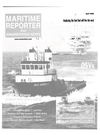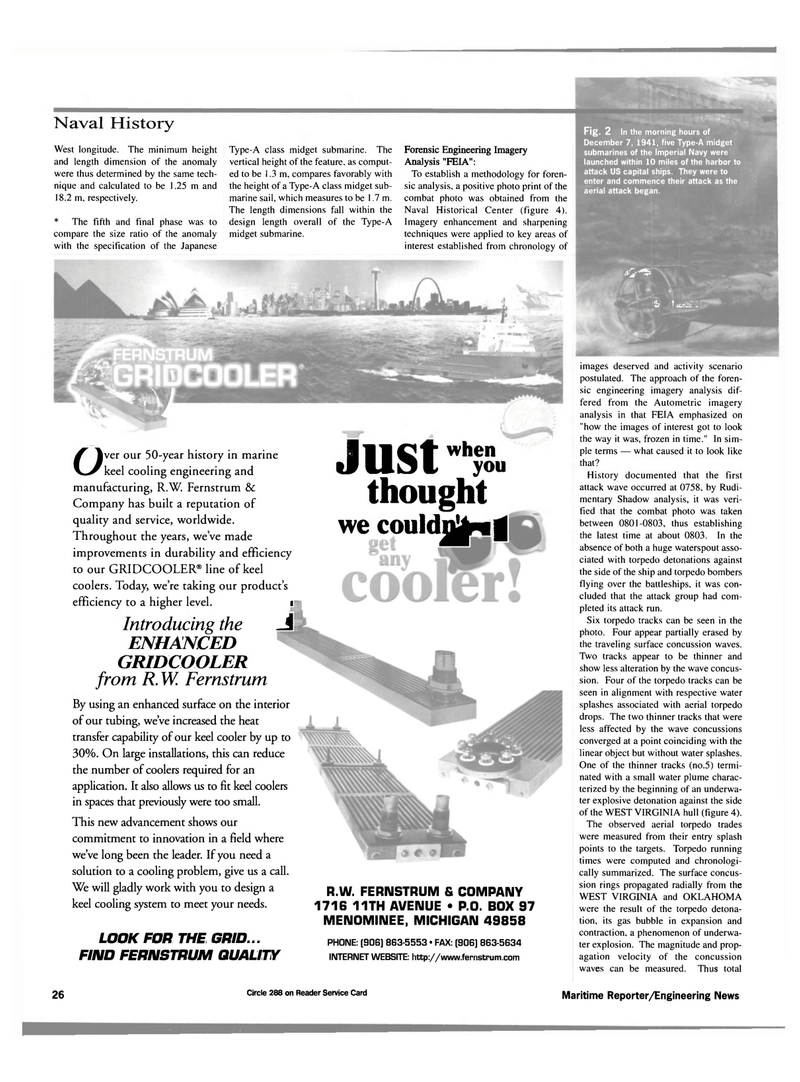
Page 26: of Maritime Reporter Magazine (April 2000)
Read this page in Pdf, Flash or Html5 edition of April 2000 Maritime Reporter Magazine
Naval History
West longitude. The minimum height and length dimension of the anomaly were thus determined by the same tech- nique and calculated to be 1.25 m and 18.2 m, respectively. * The fifth and final phase was to compare the size ratio of the anomaly with the specification of the Japanese
Type-A class midget submarine. The vertical height of the feature, as comput- ed to be 1.3 m, compares favorably with the height of a Type-A class midget sub- marine sail, which measures to be 1.7 m.
The length dimensions fall within the design length overall of the Type-A midget submarine.
Forensic Engineering Imagery
Analysis "FEIA":
To establish a methodology for foren- sic analysis, a positive photo print of the combat photo was obtained from the
Naval Historical Center (figure 4).
Imagery enhancement and sharpening techniques were applied to key areas of interest established from chronology of
Fig. 2 In the morning hours of
December 7, 1941, five Type-A midget submarines of the Imperial Navy were launched within 10 miles of the harbor to attack US capital ships. They were to enter and commence their attack as the aerial attack began. jfgr^Si if t
LOOK FOR THE GRID...
FIND FERNSTRUM QUALITY
PHONE: (906) 863-5553 • FAX: (906) 863-5634
INTERNET WEBSITE: http://www.fernstrum.com images deserved and activity scenario postulated. The approach of the foren- sic engineering imagery analysis dif- fered from the Autometric imagery analysis in that FEIA emphasized on "how the images of interest got to look the way it was, frozen in time." In sim- ple terms — what caused it to look like that?
History documented that the first attack wave occurred at 0758, by Rudi- mentary Shadow analysis, it was veri- fied that the combat photo was taken between 0801-0803, thus establishing the latest time at about 0803. In the absence of both a huge waterspout asso- ciated with torpedo detonations against the side of the ship and torpedo bombers flying over the battleships, it was con- cluded that the attack group had com- pleted its attack run.
Six torpedo tracks can be seen in the photo. Four appear partially erased by the traveling surface concussion waves.
Two tracks appear to be thinner and show less alteration by the wave concus- sion. Four of the torpedo tracks can be seen in alignment with respective water splashes associated with aerial torpedo drops. The two thinner tracks that were less affected by the wave concussions converged at a point coinciding with the linear object but without water splashes.
One of the thinner tracks (no.5) termi- nated with a small water plume charac- terized by the beginning of an underwa- ter explosive detonation against the side of the WEST VIRGINIA hull (figure 4).
The observed aerial torpedo trades were measured from their entry splash points to the targets. Torpedo running times were computed and chronologi- cally summarized. The surface concus- sion rings propagated radially from the
WEST VIRGINIA and OKLAHOMA were the result of the torpedo detona- tion, its gas bubble in expansion and contraction, a phenomenon of underwa- ter explosion. The magnitude and prop- agation velocity of the concussion waves can be measured. Thus total
Just wh$« thought we colliding
Over our 50-year history in marine keel cooling engineering and manufacturing, R.W. Fernstrum &
Company has built a reputation of quality and service, worldwide.
Throughout the years, we've made improvements in durability and efficiency to our GRIDCOOLER® line of keel coolers. Today, we're taking our product's efficiency to a higher level. i
Introducing the J
ENHANCED
GRIDCOOLER from R. W. Fernstrum
By using an enhanced surface on the interior of our tubing, we've increased the heat transfer capability of our keel cooler by up to 30%. On large installations, this can reduce the number of coolers required for an application. It also allows us to fit keel coolers in spaces that previously were too small.
This new advancement shows our commitment to innovation in a field where we've long been the leader. If you need a solution to a cooling problem, give us a call.
We will gladly work with you to design a keel cooling system to meet your needs.
R.W. FERIMSTRUM & COMPANY 1716 11TH AVENUE • P.O. BOX 97
MENOMINEE, MICHIGAN 49858 26 Circle 288 on Reader Service Card Maritime Reporter/Engineering News

 25
25

 27
27
